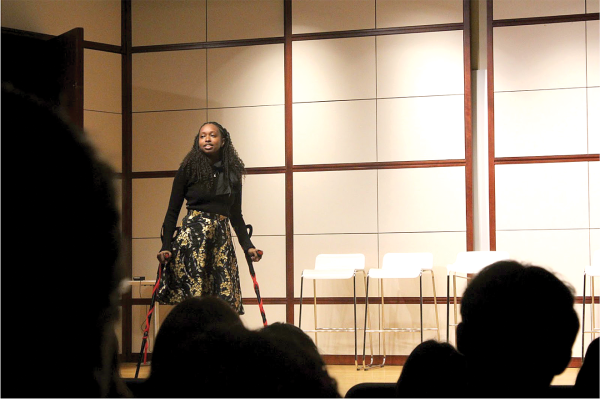November 2, 2023

Ellice Patterson speaking about Abilities Dance Boston at an event at Boston University on October 14, 2023. Vanessa Lee photo
Prancing gracefully across the dance floor with her striking red crutches, Ellice Patterson performs a modern dance on stage. Elegantly lifting her legs one at a time, she balances her body on her crutches, with each limb moving delicately and her facial expressions rich with emotion.
As a dancer with disabilities, Patterson moves in beautiful, unique ways.
She is the founder and choreographer of Abilities Dance Boston, a professional dance company consisting of dancers with and without disabilities. She will be leading and choreographing the team’s show this month in Dorchester, The Banned Ballet.
“I want to be able to create space in dance for everyone,’’ she said.
The story of this ballet consists of fictional characters, but the underlying message is relevant: a response to recent book bans, controversial acts of censorship, happening around the United States. Many US public institutions are restricting books deemed inappropriate or offensive in certain states. Patterson said the fairytale highlights themes of queerness and disabilities, as the current book bans affect marginalized communities specifically.
“It is a fairytale that I wrote about a librarian being frustrated about the book bans that have hit her community and her being swept into this fairytale book,” Patterson said.
Patterson said The Banned Ballet consists of themes related to her identities as a disabled, Black and queer woman.
“It’s just a ballet about resistance,” Kate O’Day said, a dancer with Patterson’s company. “It’s told through storytelling, which is like an accessible form of digestion of information.”
The Banned Ballet will be premiering in-person and livestream on Nov. 3 and 4 at 8 p.m. The in-person show will take place at Dorchester’s Strand Theatre.
Patterson, 29, has been dancing since the age of 4. Her love for dance began back home in rural Mississippi. But when she came to Boston for college, she wasn’t able to get space to perform professionally. Patterson said there was no professional dance company that accepted her, for a variety of reasons, whether there were not any spaces for disabled dancers or whether choreographers were unwilling to accommodate their dance companies’ performances.
This drove her to start her own company to “create work that not only considers different accommodations in the process, but also highlights the intersectionality [of] disability cultural stories within the work itself,” she said.
Starting her business was rocky at first, but Patterson saved money from tips she earned bartending to fund her first show. Patterson believes barriers she faced in her career were not because of her disability, but due societal limitations that imposed barriers.
“Every day is a different battle,” Patterson said, noting the challenges of being Black, queer and a woman. “And that is the unfortunate reality that a lot of my colleagues don’t have to face.”
Her company raises funds to cover ticket prices for people who cannot afford to pay to see their performances.
O’Day said fundraising from donors is “a great way to support” the company’s goal in increasing inclusivity for participants and audience members.
The dance company also receives funding from the Mass. Cultural Council, including $36,100 in various grants programs, said council senior director of public affairs Bethann Steiner.
“[Abilities Dance Boston is] truly a leader when it comes to access to the arts and culture here in Massachusetts,” Steiner said.
Patterson said besides the council’s donations, her company also raises funds that make up a large portion of the company.
Lizbeth Romero, programming coordinator at the dance company, said Patterson is trying to “de-stigmatize dance” and change the narrative around what people with disabilities are “supposed to do.”
Romero, who is not disabled, said the dance company helped her learn more about her own biases, and she praised the dancers for passionately showcasing all that they can do, saying she could “just tell by the way their bodies move,” she said.
During Patterson’s dance on stage, she lets go of her crutches mid-performance. She is on the ground and on her knees, performing movements with her upper body. The stage was captured on video and shared with supporters.
As she dances, Patterson changes the narrative around movement for all bodies.
She also is working to change minds.
Patterson, in an interview, encouraged people of all abilities to not restrict themselves when it comes to dance.
“Don’t hesitate to figure out ways to make current spaces you might be in, to work for you,” Patterson said.
This story was published as part of a collaboration with Boston University’s School of Journalism in the College of Communication. The student journalist is a member of a class taught by former Boston Globe reporter Meghan Irons.


